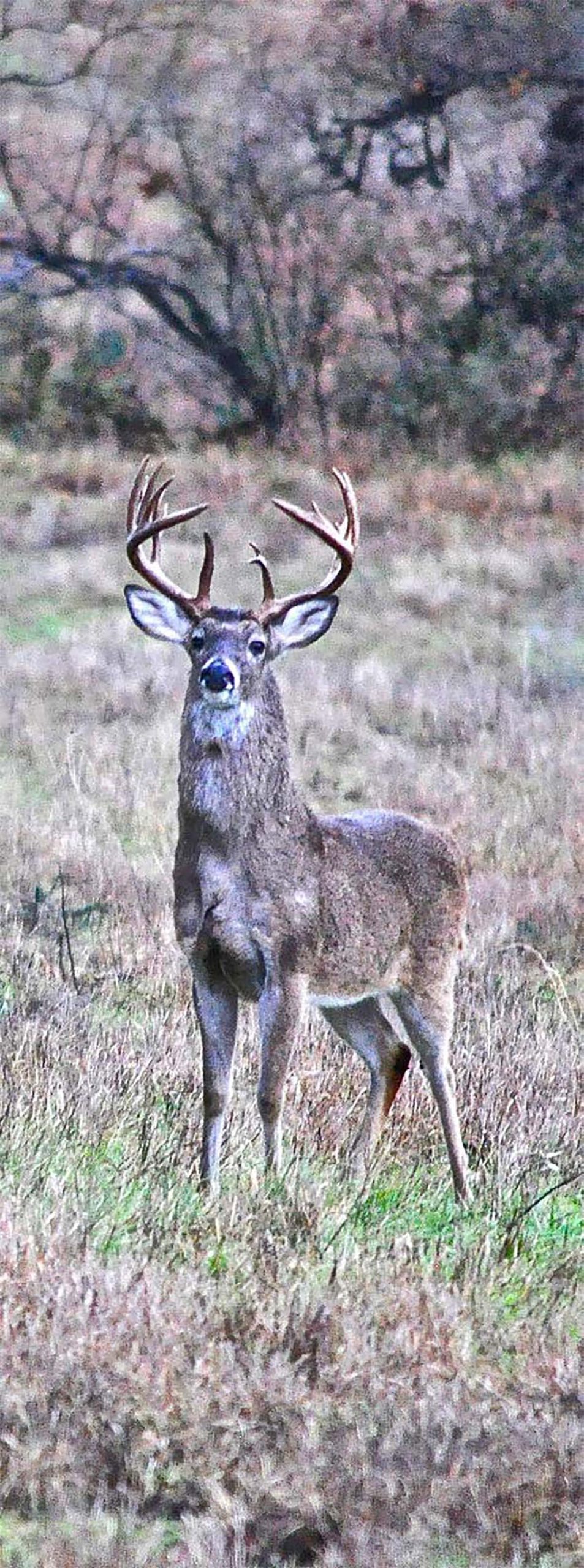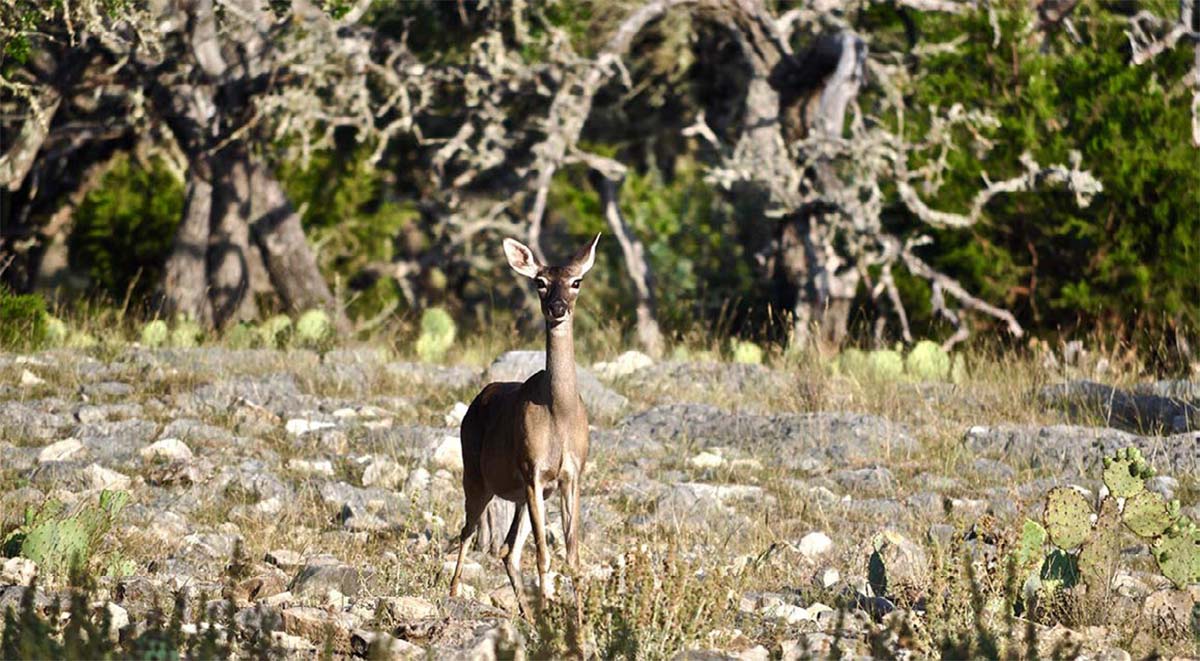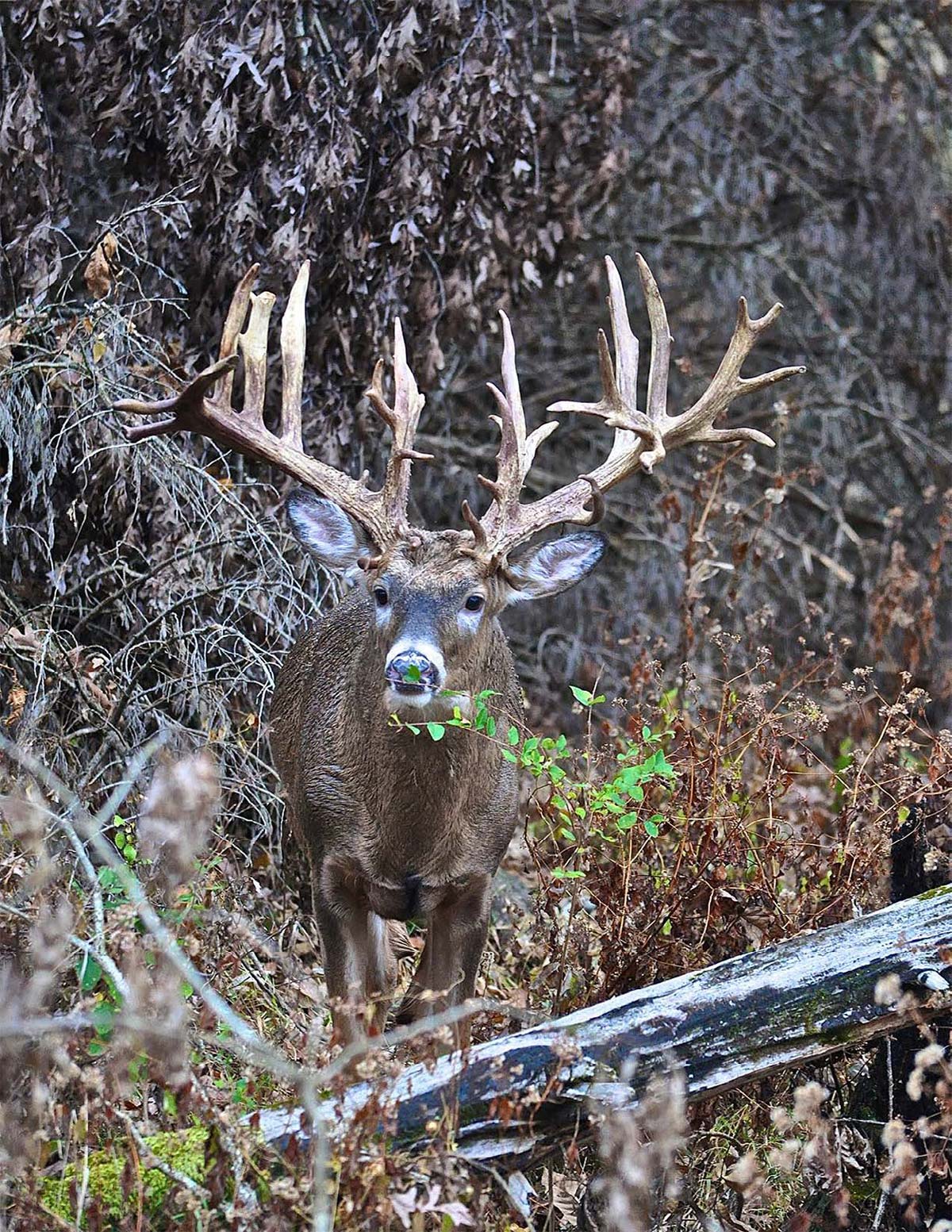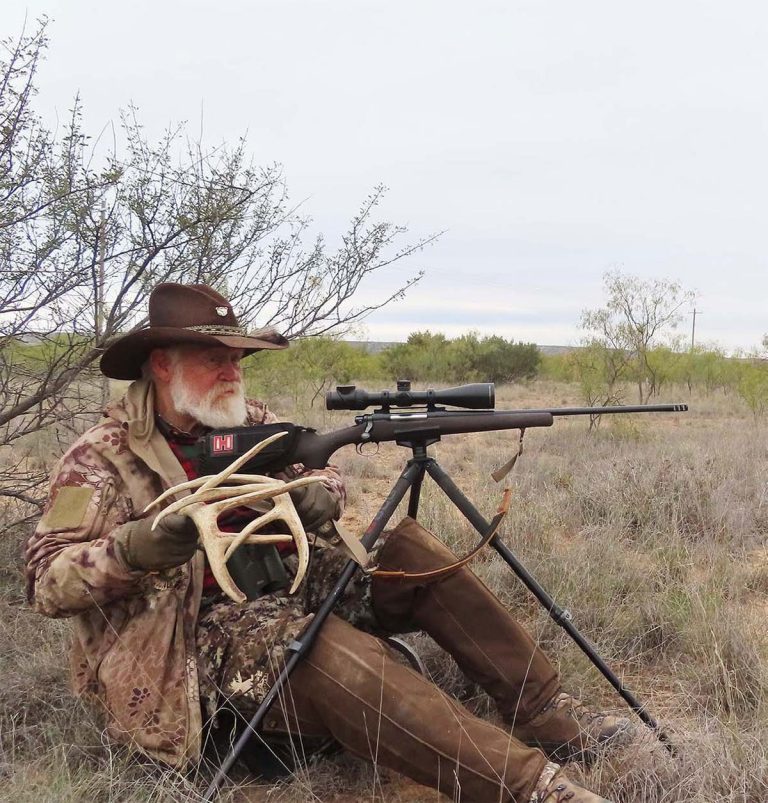This was the conversation taking place at the Harrisburg Sports Show.
“I’ve tried rattling for the past three years. Nothing has responded. I’m probably scaring deer away! I think you’re promoting another Texas myth,” a red and black plaid-shirted attendee exclaimed.
I looked around the room where I was speaking. Several people attending my assigned topic, “Rattling Whitetails,” nodded in agreement. This occurred years ago before that huge outdoor show was taken over by the National Rifle Association.
I retorted with a smile. “Another Texas myth? Let’s talk a bit more about rattling, then later you can tell me what those other Texas myths are.”
Here’s what I told that audience. “Last fall I hunted deer on property about 30 miles east of where we are right now. I was invited by a man I met while hunting caribou in Quebec with Jack Hulme. That person owns 150 acres surrounded by smaller places. He and all his neighbors hunt deer. The property is in an area where “If it’s brown, with legal antlers, it’s down!” I grew up hunting similar situations in Texas. Not all of Texas had big deer nor lots of them back then. If you shot a buck in our rural community, you were a hero!”
That conversation continued. “Back then, just north of the Texas Gulf Coast, only bucks with branched antlers were legal. Bucks did not get the chance to live very long. The vast majority of the annual deer harvest was comprised three- and four-point yearlings.” I added, “I first heard about rattling in bucks as a nine-year-old when a cousin hunted a ranch in South Texas’ Brush Country near Laredo. He came back with the largest- racked eight-point I had seen. He told of how one of the ranch’s Mexican cowboys had taken two deer horns and banged them together and his buck came charging in! Later the same day, the vaquero rattled in another buck for my cousin. This one had horns so big it shook him badly and he missed it four times before it disappeared into the thorn bushes. If what he called “rattling” worked farther south, it surely should work where we hunted as well.”

I continued to report about the issue of the buck-to-doe ratio, and that it was likely one buck per 15 or more does, because every legal buck seen was shot. That was not an ideal herd composition for making rattling highly successful.
In this scenario, my first step was to find rattling horns. I doubted the small fork horns racks offered me would make a loud enough sound for deer to hear. I finally talked a neighbor out of three-point mule deer rack he had picked up hunting in Colorado. I cut both antlers off the skull then headed to the woods behind our house, believing I could rattle in the biggest buck in the county. Hunting season had closed a month earlier. I roamed throughout our woods hitting my rattling horns together. All I got for my efforts were bruised fingers and knuckles. I did slip in close to what I thought was a buck. When I hit my rattling horns together, that deer ran away, tail wagging. I thought about calling my cousin and telling him he was full of it, and I didn’t mean full of truth! It did not occur to me I was trying to rattle in bucks when most had already shed their antlers and had no desire to fight.”
Seven hunting seasons later on, during an early November morning, I finally rattled in my first bucks. Our local deer population had increased. Local hunting habits and practices had not. Most bucks were still being shot as yearlings. However, I learned that our rut usually started the last week of October. I had read that bucks respond to rattling during the late pre-rut, early rut, the rut and the post-rut.
I continued my tale. “From high in my oak-tree deer stand on the second week of the November opener, come first legal shooting light, I banged my rattling horns together. Even though I had been unsuccessfully rattling now for several years, I never lost confidence that the technique would eventually work. I meshed the antlers together, the same ones I had used for years. I had kept them inside during the off-season so they would not dry out or become “chalky.”
I had just started my second series of rattling when two bucks came to investigate. One was a small six-point, and the other was an eight-point. They were looking for the simulated buck fight. In that situation, I nearly dropped my rattling horns and my Dad’s borrowed Model 94 .30-30. I shook all over as I lowered the horns and raised the rifle in the general direction of the closest buck. Sights were all over the deer.
Years later when I looked back, I realized that I undoubtedly closed my eyes and jerked the trigger when I shot because. I widely missed that buck. I missed not only once, but twice! While it was disappointing it was also tremendously exciting! I had really rattled in my first bucks!”
That led to my next point regarding this attendee’s statement. My host told me he had kept records of the bucks and does he had seen on his property for the past three years. Based on those observations, the buck-to-doe ratio was one buck to 11 The bucks seen were mostly yearlings along with very few two-year-olds or older deer.”
While there, I decided to try to rattle in a buck for my host. We argued about my being the shooter, and he lost! So, way before first light, we headed to a stand in the center of his property. He crawled into his platform treestand so he would be able to see any buck that approached. I stayed on the ground to rattle, sitting in tall underbrush. We intended to stay on stand all day. When legal shooting time arrived, I started meshing my rattling horns, which were shed antlers from a long-tined 10-point, now sans brow tines. Nothing showed up, though we heard many shots both near and far.”

So, there we were, and it was a little after 10 o’clock, and the shooting had ceased. Obviously, most hunters were heading to or were already back at camp. I looked up toward my host. He was still attentive. I got comfortable and took a nap. I awakened just before 11 a.m. After getting my host’s attention with a series of grunts, I started rubbing an antler on a nearby bush. After doing so for about a minute, I stopped, waited 10 or so seconds, then scraped the ground three times. I hesitated for a bit then did it four times more. For years, I had been watching bucks make scrapes. I had noted that almost always, bucks rake the ground no less than three nor more than five times with each front foot.
With the scrape completed, I did a few natural-voice, guttural “aaacckk” grunts. Then I again rubbed a nearby bush. With the rubbing completed 20 seconds later, I did a natural-voice sound of “fit, fit, fit, fffeeeeeeeeeeee,” snort/wheeze. Moments later I slammed my rattling horns together and started meshing the tines. At the same time, I dug my heels into the ground and started pushing, doing my best to imitate two bucks pushing against each other.
About 30 seconds into my rattling, I heard a bang! My host had taken a shot, followed immediately with the exclamation, “I GOT ‘EM! HE’S DOWN!”
A couple of minutes later we were standing over my host’s biggest buck ever. It was a really nice buck, likely three-years old and a 10-point. He told me that the scenario I presented had worked. It was that as soon as I banged my rattling horns together (after setting up a scenario of two bucks meeting and challenging each other, then starting to fight the buck charged in from downwind), the buck stopped less than 20 steps from where I was seated on the ground and stared in my direction. Because of the dense brush, I never saw the buck until the two of us walked up to him.”
The lesson here is that regardless of the deer population, buck-to-doe ratios and hunting pressure, Whitetail bucks do respond to the sounds of two bucks fighting—not always.”
Over years, I have rattled in bucks in many places, including where there were very few bucks to be found. Remember that bucks have to be able to hear the rattling, and they have to be in the right testosterone-heightened state of mind to want to respond. So, I suggest that you don’t give up on rattling or be afraid to try it where you hunt. But also try it different hours of the day, not just early and late.”
At the end of this discussion, most of those in the crowd nodded in agreement at my story and suggestions. As I finished the presentation, I pointed to the original questioner. “Now tell me about those other Texas myths,” I mused. He simply smiled and waved.

Fast-forward many years after that presentation, and I have continued to learn much about rattling Whitetail bucks, but many of the basic tactics and techniques remain. Here are some things I have learned. I like to note that I also continue to learn each time I head to the deer woods with my rattling horns.
- With a little set of rattling horns (I know, they’re antlers and not horns) you can make a little noise. With a larger set of rattling horns, you can make a little bit of noise or a much louder-sounding fight. I prefer larger antlers, sheds, using both left and right side. I remove brow tines so I do not poke myself when in the heat of “the battle.”
- The more bucks there are in an area, the better the chance one or more will respond when you rattle. This is partly why bucks respond better where the buck-to-doe ratio is narrow, but it also has to do with the increased number of bucks in the area.
- Bucks can generally be rattled in starting once you see the first active scrapes.
- Pre-rut and late pre-rut when bucks are roaming looking for does are the best times to rattle.
- What time of day bucks minimally or best respond to rattling varies from day to day. Sometimes they best respond early, late, mid-morning, mid-afternoon or even straight up until noon. So, rattle throughout the day. If you do not rattle in a buck, try rattling again an hour or so later. I like to hunt all day. Every hour or so I rattle my horns. This keeps me attentive and focused. Often, I rattle in bucks during mid-day while others are back in camp.
- Dare to rattle different ways, for shorter periods of time, longer periods of time, less aggressively and more aggressively. Add grunts, groans and snort-wheezes to your rattling sequence (or not). If bucks respond to what you are doing, do it again. If they do not, try something different.
- It does no good to rattle in bucks if you or your hunting partner cannot see them. This was one of the reasons I addressed putting a hunting partner in a tree where he or she could see considerably more territory than I could sitting on the ground.
- Bucks responding to rattling horns will almost always circle to come in from downwind of your position. Wary and even rutting bucks look and see, but they depend upon their sense of smell most of all for their safety. Occasionally a buck will charge in from upwind, but then it will start circling your position to get downwind of the sounds being made to “catch the scent.”
- When setting up, I do so where I have found scrapes and rubs, then position myself where I am watching downwind and have shooting lanes to my left and right. I want to see and get a shot at any approaching buck before he gets downwind of me. This is one of the reasons I shoot both right-and left-handed.
- Yearlings through three-year old bucks generally respond more readily and more quickly than mature bucks do. I have learned the hard way that older mature bucks generally tend to be slow in responding. Older, bigger antlered, bucks may come to the sound of rattling horns and stand just out of sight downwind for 20 to 30 minutes before stepping clear where they can be seen. Stay on a “rattling stand” at least 20 minutes after you finish rattling. Doing so sometimes pays huge dividends!
- Bucks can be rattled in while the hunter is in a treestand or a deer blind. If in an enclosed blind, stick the antlers outside and rattle, so the sound is not “muted” or distorted.
- During early pre-rut I rattle gingerly or timidly like bucks sparring. Closer to the rut I rattle louder and longer at that point too. I strive to make as much noise as I can by breaking limbs, kicking the ground, rolling rocks, and being more vocal. Bucks sometimes utter the snort-wheeze, a “fit, fit, fit, ffffeeeeeeeee” sound mentioned earlier, to challenge or intimidate another buck. Two bucks when fighting will sometimes utter a long, loud groan to help them “bolster” their energy, not unlike a professional athlete. As the rut winds down, bucks still respond to rattling horns, but usually are a bit slower responding. By then they have been rutting and fighting for several weeks.
- There really is no absolute when it comes to how long to rattle. I have seen big mature buck fights last mere seconds, but also as long as eight-hours. In the case of the latter, I have seen bucks fight until they are exhausted, standing with racks together and breathing very loudly, when finally, one buck catches his breath, and the fight is on again. Neither buck wants to turn tail because as soon he does, the other is going to poke his backside full of holes with his antlers.
- Occasionally does respond to rattling horns. Usually when this happens, she is being followed by a very young or a very old buck. I am convinced she wants nothing to do with the buck following her. Instead, I think she is coming to the sound of two bucks fighting to check them out and to drag the buck following her into the fight so she can escape.
- I very occasionally use deer decoys and more regularly use scents when rattling. I use decoys so the responding buck sees what looks like a deer when he approaches. Scents are more important if you hope to fool a buck’s sense of smell. I use a variety of deer scents from bucks and does when I rattle. Bucks hear and look, but they depend on their sense of smell for life and death.
- When I have the space to do so I like to rattle, staying there 20 to 30 minutes after I finish rattling, then move at least 300 yards before setting up to rattle again. The distance moved between setups depends upon wind velocity and habitat, the more open, the farther I move. The higher the wind the less distance I move between set ups. I generally always walk either into or quartering to the wind when moving to a new rattling set-up.
- I have no qualms about going back to the same area I rattled earlier in the day to rattle there again or the following day. Deer move and sometimes bucks simply do not respond, but they will at another time or another day.

Why do bucks respond to the sound of two bucks fighting? Honestly, I’m uncertain about it. Whitetails are not truly territorial. There may be one or more dominant bucks in any specific area. Remember too, that dominant bucks do not necessarily have big antlers. Quite often, such bucks are big-bodied eight-points or bucks with small bodies but deer that like to fight. During the rut, testosterone is at an all-time high. Because of this, bucks are in a continual state of agitation and excitement. Perhaps, that is why they respond. Even though I cannot truly explain or know why bucks respond to rattling horns, the important fact is…they do!
If you have not yet rattled in your first buck, do not give up trying. It will happen! Once you do, you will surely believe as I do that rattling is the most fun and exciting way to hunt Whitetail deer.
Per our affiliate disclosure, we may earn revenue from the products available on this page. To learn more about how we test gear, click here.







